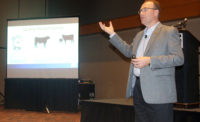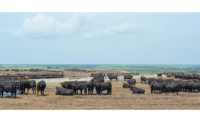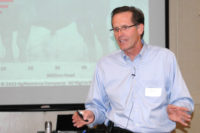A 'new realm' for demand
Economist Dan Basse says beef, corn prices will move higher over the next several years.

If strong beef demand is poised to be the highlight of the cattle markets going forward, competition for feed grains will be the lowlight.
Dan Basse, president of AgResource Co., spoke at the Certified Angus Beef (CAB) Feeding Quality Forum in Fort Collins, Colo., in late August. He had one main action point for attendees: “I think your big job in the cattle industry is covering and managing feed costs.”
Grain stocks will remain low, both due to supply issues and demand growth ranging from global feed use to domestic fuel.
The China factor
African swine fever (ASF) reduced China’s hog herd by 40% in 2018.
“The Chinese said, ‘We’re going to build that hog herd back,’ and they have done that,” Basse said. “They’re the only country in the world that has recovered that quickly in terms of its ability to rebuild meat supplies.”
In doing so, they’ve traded food waste byproducts for Western swine diets, which has quadrupled the amount of feed-grain imports they’re buying from the United States. China now buys one out of every four bushels of feed grains in the world.
“That’s a big deal,” he said. “China will be taking lots and lots of corn for years to come.”
U.S. grain farmers anticipated big margins going into 2021 — up to $300 and $400 per acre — and yet didn’t plant as many corn and soybeans as expected. “We did not see the big acreage gains we were hoping for,” Basse said. “There is no more expansion. Urbanization has taken those acres away.”
According to USDA, crop acreage planted sits at 317.2 million acres, up from 310.1 million acres last year. Gains came from less productive corn states such as the Dakotas, which have also been hit with drought this growing season.
Other countries have had drastic weather challenges of their own, such as drought in Russia and frost and drought in Brazil.
“World corn trade is still very, very strong. It hasn’t changed,” Basse noted. “So, when I look at world exporters’ stocks-to-use ratios, there’s going to be a shortage of corn in the world. This forces all the demand back to the U.S.”
If there’s a major weather problem in the United States, Argentina, or Brazil, he wouldn’t be surprised to see corn prices climb to $8.50 per bushel or higher.
“I don’t think corn is going back to anything with a sub-five in front of it for the years to come,” Basse said, encouraging feeders to look for opportunities in the market to price grains.
Food vs. fuel
Part of the pricing scenario comes from competition in the soybean market. Renewable biodiesel, now being produced from soybean oil, is becoming a popular choice for major companies that want to reach carbon neutrality. Airlines will be a major driver, and this is poised to draw more acres out of corn or minor crop production to shift to soybeans.
“This is probably as disruptive to the market, an ag market, as anything I have seen in my 42-year career,” Basse said.
This year 87 million acres of soybeans were planted across the United States.
“How many acres are farmers going to have to plant of soybeans to meet this demand of what’s called carbon-neutral, renewable diesel?” he asked.
In demand
Even if feed prices are a concern, strong beef demand should bolster cattle prices, Basse said.
“There has not been a better demand period that I can see for beef looking backward for the past 10 to 15 years,” he said.
U.S. consumers have more disposable income, due in part to federal COVID-19 relief payments. As a result, consumers are eating more beef.
Globally, animal protein consumption is increasing, and the “feeding 9 billion people by 2050” mantra is still an important topic, Basse said.
Increased standards of living in countries like China, India, Vietnam, Thailand and Cambodia will drive food consumption for the next eight to nine years. “This is going to be a bullish factor for the livestock markets and the beef markets going forward,” he said.
ASF gave U.S. beef products an “in” to the Chinese market, Basse said. “I don’t think China’s appetite for beef is going away. I think it’s going to get stronger.”
Except for the May-June timeframe, 2021 beef exports have been at 10-year highs. That’s despite exponentially higher costs (up to $20,000 per container) to get the refrigerated shipments into the region, Basse said.
“On the cattle side of things, you guys should feel relatively comfortable with the demand profile, not only from our domestic consumer, but also from our friends overseas in southeast Asia,” he said.
The current herd liquation phase, made more dramatic by widespread and prolonged drought in the West, will also prop up cattle prices.
“The long term on cattle looks really quite extraordinary and bullish for the next couple of years,” he said. “We are really kind of in a new realm.”
Editor’s note: This article was originally written for the Angus Beef Bulletin and is reprinted with permission from Angus Media.
Looking for a reprint of this article?
From high-res PDFs to custom plaques, order your copy today!






